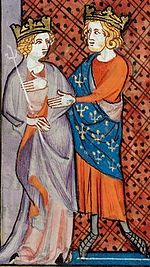Bertrade of Montfort
| Bertrade de Montfort | |
|---|---|
 Bertrade with Philip | |
| Queen consort of the Franks | |
| Tenure | 1092–1108 |
| Born | c. 1070 |
| Died | 14 February 1117 (aged 46–47) |
| Spouse | Fulk IV, Count of Anjou Philip I of France |
| Issue | Fulk of Jerusalem Philip, Count of Mantes Fleury, Seigneur of Nangis Cecile, Princess of Galilee |
| House | House of Montfort |
| Father | Simon I de Montfort |
| Mother | Agnes of Evreux |
| Religion | Roman Catholicism |
Bertrade de Montfort (c. 1070 – 14 February 1117) was a queen consort of France by marriage to Philip I of France.
Life
She was the daughter of Simon I de Montfort[1] and Agnes of Evreux. Her brother was Amaury de Montfort.
In speaking of Fulk IV, Count of Anjou, the chronicler John of Marmoutier would recount:
The lecherous Fulk then fell passionately in love with the sister of Amaury de Montfort, whom no good man ever praised save for her beauty.
Bertrade and Fulk were married,[1] and they became the parents of a son, Fulk, but in 1092 Bertrade left her husband and took up with King Philip I of France. Philip married her on 15 May 1092, despite the fact that they both had spouses living. He was so enamoured of Bertrade that he refused to leave her even when threatened with excommunication. Pope Urban II did excommunicate him in 1095, and Philip was prevented from taking part in the First Crusade.
According to Orderic Vitalis, Bertrade was anxious that one of her sons succeed Philip, and sent a letter to King Henry I of England asking him to arrest her stepson Louis. Orderic also claims she sought to kill Louis first through the arts of sorcery, and then through poison. Whatever the truth of these allegations, Louis succeeded Philip in 1108. Bertrade lived on until 1117; William of Malmesbury says: "Bertrade, still young and beautiful, took the veil at Fontevraud Abbey, always charming to men, pleasing to God, and like an angel." Her son from her first marriage was Fulk V of Anjou who later became King of Jerusalem iure uxoris. The dynasties founded by Fulk's sons ruled for centuries, one of them in England (Plantagenet), the other in Jerusalem.
Children
With Fulk IV, Count of Anjou:
- Fulk of Jerusalem, Count of Anjou and King of Jerusalem (1089/92–1143)[2]
With Philip I of France:
- Philip of France, Count of Mantes (living in 1123)[3]
- Fleury of France, Seigneur of Nangis (living in 1118)[4]
- Cecile of France (died 1145), married (1) Tancred, Prince of Galilee;[5] married (2) Pons of Tripoli[6]
References
- ^ a b Blacker 1998, p. 46.
- ^ Hollister 2001, p. 226.
- ^ Bradbury 2007, p. 131.
- ^ McDougall 2017, p. 155.
- ^ McDougall 2017, p. 159.
- ^ Hodgson 2007, p. 217.
Sources
- Blacker, Jean (1998). "Women, Power, and Violence in Orderic Vitalis's "Historia Ecclesiastica". In Roberts, Anna (ed.). Violence Against Women in Medieval Texts. University Press of Florida.
{{cite book}}: Invalid|ref=harv(help) - Bradbury, Jim (2007). The Capetians: The History of a Dynasty. Bloomsbury Publishing.
{{cite book}}: Invalid|ref=harv(help) - Hodgson, Natasha R. (2007). Women, Crusading and the Holy Land in Historical Narrative. The Boydell Press.
{{cite book}}: Invalid|ref=harv(help) - Hollister, C. Warren (2001). Henry I. Yale University Press.
{{cite book}}: Invalid|ref=harv(help) - McDougall, Sara (2017). Royal Bastards: The Birth of Illegitimacy, 800-1230. Oxford University Press.
{{cite book}}: Invalid|ref=harv(help)
